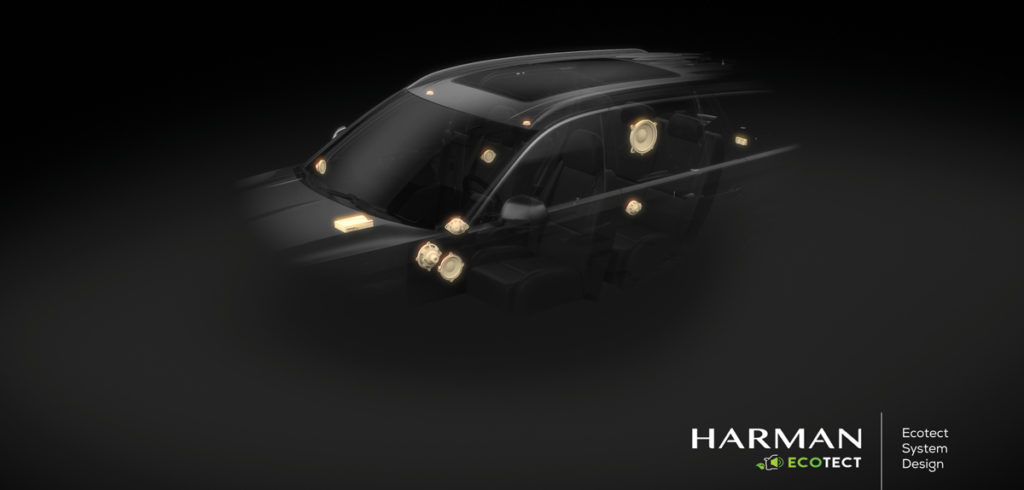How optimized in-car audio helps EV manufacturers increase efficiency
With the manufacturers of EVs scouring every avenue of development in order to increase efficiency and thus range, it should come as no surprise that the power draw and weight of in-car entertainment systems is under scrutiny.
Harman, which supplies OEMs with in-car audio solutions, is looking to address these concerns with its new Ecotect system design for electric vehicles. Automotive Interiors World spoke to Riley Winton, responsible for development of the system, about how it is achieving both efficiency and weight gains without compromising sound quality.
What is your background?
I’m part of the Epic Experience Team at Harman. We’re involved with basically bringing new concepts to life in automotive space. Think of us as the bridge between pure R&D, looking far out into the future, and production implementation. We’re where those two worlds meet, bringing in new ideas and building experiences around them.
My background is HCI, or human computer interaction, and psychology as well as acoustic; I started as an audio or music systems engineer. So, if you go to the dealership and buy a new car with a branded audio system like a JBL or a Harman Kardon, I was on the team that built and tuned those systems in the car. I cut my teeth in the nuts and bolts world of audio and acoustics in-car.
How is Harman working to develop dedicated in-car systems for EV manufacturers?
We asked our core customers, OEMs, ‘What are your pain points? What are your challenges when you’re making these cars?’ A lot of them responded – weight. It’s a huge thing when building and designing any car, getting it certified, making it efficient, etc. But when you look at EVs, especially, it’s even more critical. It directly opposes the battery and the powertrain and when it comes to efficiency of the vehicle, every additional gram you put in that car is going to decrease your driving range. Range anxiety is a huge part of the bottleneck stopping people adopting EVs right now.
This led us to ask the question, ‘What would a good audio system need to be to make a successful EV platform?’ We looked at weight, power draw, complexity, etc.
On that last point, a lot of the OEMs are really struggling with complexity. They’ve got multiple vehicles, and each vehicle has multiple levels of trims. And then sometimes even those same levels of trim have multiple levels of audio system.
So not only must an OEM manage each of these independently, which can be a monumental task, but then it is managing all of the related supply interactions; which part numbers go in which region and where should they be produced? It’s a nightmare which can turn into a huge nightmare very, very quickly. Complexity also adds weight and power consumption. Ecotect seeks to address that complexity.
How did you try to reduce that complexity?
The first thing we did is just look at the layout of the systems. In most car audio systems, you typically are always going to have four door woofers. They are easy to package, easy to carry over from model to model. But frankly, they’re usually heavy. They require a lot of additional wiring and a lot more engineering to support the door opening and closing, etc.
Our solution to simplify this element is called ECS (externally coupled subwoofer). Rather than having a sealed, big heavy enclosure or a box in the door, which acoustically speaking most subwoofers need, what we do is imagine taking the car as a box and then putting the subwoofer in the sheet metal of that box. The entire car cabin becomes the enclosure of the subwoofer.
This is more efficient; it’s space and weight efficient because you remove the enclosure that otherwise would be necessary and reduce a lot of other extra components just to support the speaker.
We then have ICSs (internally coupled subwoofer). Again, a normal interior subwoofer usually has a dedicated plastic or metal or some kind of heavy box. Well, a car is already made of a lot of small sheet metal compartments , so what we do is, for lack of a better term, hijack one of these existing sheet metal cavities, and then turn that into the box. Again, it’s a volume and weight saving effort, because we already have the acoustic volume we need.
What other elements go into reducing the complexity?
A couple other key things. First we have our direct firing speakers. These are not a huge thing for efficiency, but from a spatial audio perspective very important, getting a really good soundstage with good imaging. A lot of the time, systems have mid-range speakers and tweeters on the dashboard, and they fired up into the windshield.
This works but you’re obviously going to be dealing with some not-so-nice reflections and some other issues. To get around that we actually put our mid ranges and our mid tweeters in the A-pillars of the vehicle pointing directly at you. This is how speakers would be arranged in a tuned reference audio room, it gives a more accurate spatial response and a little bit more efficiency as well as, again, the speakers are in a smaller footprint.
The last thing is our unity coaxial speakers. To be honest, there is nothing extremely groundbreaking here. Coaxial speakers have been around for decades. But again, just the idea of getting two speakers in one footprint, which reduces weight, reduces the number of amp channels, reduces power, etc.
These are all the ingredients in the recipe, if you will. We put them all together, and have made a layout of a system that gives you the best bang for your buck.
We can scale it all the way down for the small car segment. You can have three channels, maybe four channels of speakers, only in three different locations, yet you can still get really powerful sound with a good spatial mix. Or you can scale it right up for a luxury car.
Beyond simply reducing complexity and simplifying the layout, what other steps can you take to improve overall efficiency in terms of the whole vehicle?
Efficiency is a characteristic of an entire system. It’s not just a speaker. It’s not just an amp, and it’s also not just the architecture that I described. It’s everything put together. That said, there are a few, I guess you’d call them magic pieces, some new proprietary tech that drive it all. The core is what we are calling our Prodigy amplifier, which is powered by a discrete class D topology.
Being a class D amplifier, it is very efficient, but most existing class D amplifiers use mass-produced integrated circuits. Those are great because you can just pull them off the shelf, tweak a couple things, and you’ve got a working system.
 However, in our case, we broke the integrated circuit out into discrete components. And through that process, we get much better control because we can tweak the value of this resistor, tweak this capacitor, etc. It allows us to really squeeze out every last drop of efficiency in the amplifier design alone.
However, in our case, we broke the integrated circuit out into discrete components. And through that process, we get much better control because we can tweak the value of this resistor, tweak this capacitor, etc. It allows us to really squeeze out every last drop of efficiency in the amplifier design alone.
We’ve gained a lot of efficiency while keeping the sound quality; the transparency of the amp, the linearity, low distortion, all that good stuff. But again, we were able to squeeze out a lot more power.
Another key to increased efficiency is a new piece of software we call Power Manager 2.0. It’s pretty self-explanatory, it’s the power management software for all the signals going out to the speakers. With it we’re actually doing real-time voltage and current monitoring on every channel on the amplifier.
How does this help us save mass and power? There’s two different ways you can exploit this technology. One is that you can get more out of the speaker, you can squeeze more acoustic output from them, while not making the speakers catch fire.
However, if you go the other direction, you could say I have a system of the required performance, but I want to save mass. With this technology, you can actually downsize your speakers; reduce the magnet weight, or the cone size or whatever it may be, and instead use this technology to regain those losses in terms of performance.
How would you sum up the Ecotech approach?
the tagline for this has been ‘Fewer speakers in better places’. That’s our mentality here. To use a smaller number of speakers and just use the right, well-designed part in the right place to get the audio experience we’re looking for.



